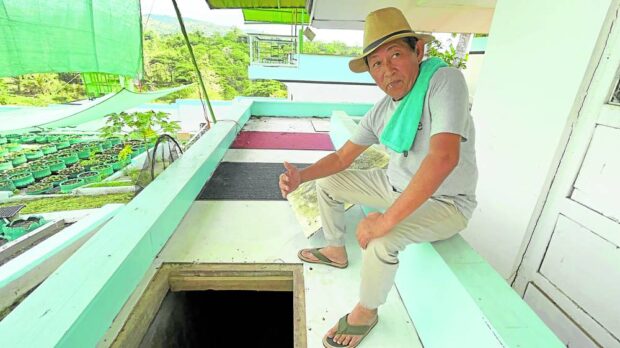Farmers in Zamboanga, Davao cities brace for El Niño

PREPARED | This rainwater catchment system developed by Ibno Turabin for his organically grown bananas and vegetables at his farm in Sitio Buenakapok, Barangay Lanzones, Zamboanga City, as shown in this photo taken on Friday, gives him confidence that his farm will survive the prolonged dry spell expected to hit around July this year. (Photo by JULIE ALIPALA / Inquirer Mindanao)
ZAMBOANGA CITY, Zamboanga del Sur, Philippines — Though El Niño is not expected to hit the country until July, farmers are already beginning to feel the effects of the dry spell on their crops.
“We are not yet in the El Niño stage but all my bitter melons are dead,” noted vegetable farmer Joseph Ledesma, 40, of Barangay Bunguiao, a mountain village some 42.2 kilometers from the city proper.
Ledesma, a member of the 1,000-strong Federation of Zamboanga Upland Farmers Association (FZUFA), said the city government should take proactive and sustainable measures, or they would suffer.
But City Agriculturist Carmencita Sanchez said on Tuesday that they didn’t see any need to declare a state of calamity, as the city has enough food resources to tide over its nearly a million population in case of a drought, noting the city was still experiencing rain on a daily basis.
“We are not going hungry during El Niño — that is, if we are really going to experience El Niño. I don’t want to be pessimistic,” she told the Inquirer in an interview last week.
Article continues after this advertisementThe city, which has a population of 977,234 based on the 2020 census, consumes around 6,000 bags or 300 metric tons of rice daily, data from the Philippine Statistics Authority in 2018 showed. The consumption rate was likely to have increased in 2023, according to Sanchez.
Article continues after this advertisementWhen grain shortage affected the city in 2018, rice sufficiency was as low as 13 percent. At present, however, the city can source most of its needs from nearby rice-producing provinces or tap the supply imported from Malaysia, said Sanchez.
Stark reality
However, the FZUFA farmers, which provide 30 to 50 percent of the city’s vegetable requirement, said they could produce only 10 to 20 percent of the city’s needs because of the prevailing heat. Vegetable production could get worse if the dry spell would continue for six months to a year, said Ledesma.
Ibno Turabin, a banana planter advocating for organic farming, warned the dry spell is real and a “stark reality” for the city’s agricultural sector: “My bananas are not growing any better, [my farm has] so little yield.”
He also believed his nine-hectare farm in Sitio Buenakapok, Barangay Lanzones, of the city and those of his fellow farmers would be gravely affected unless “the city government could think of sustainable ways to support the farmers.”
Turabin noted that a dry spell would hit the city every two years but the local government has made no effort to maximize the use of abundant rainwater during the rainy season, which occurs from six to eight months of the year, to prepare for the dry season.
Turabin had developed his own rainwater catchment system, which made him confident that the lettuce and other vegetables he also grows on his farm could survive the dry spell.
He said if farms and households were to adopt the water catchment he developed, they would no longer have to wait for water lorries to deliver water during a dry spell. Still, a local government solution would be better since water lorries only provide temporary relief, Turabin and Ledesma said.
Quick-response measures
In Davao City, the city government is focusing its measures against the prolonged drought on 13 barangays in the districts of Marilog and Paquibato, which produces the bulk of the city’s cash crops and vegetables.
City Agriculturist Edgardo Haspe said they would prioritize the city’s quick-response measures on these areas considered vulnerable to the effects of El Niño.
Haspe said the prolonged dry season, expected to hit in July and could last up to the first quarter of next year, would also bring about the likelihood of pests and plant diseases.
The Davao City Agriculturist Office was preparing a list of existing irrigation facilities and has started mapping out the most vulnerable areas in the city’s agricultural lands, particularly those in the Marilog and Paquibato districts, that would get immediate fund assistance from the city, said Haspe.